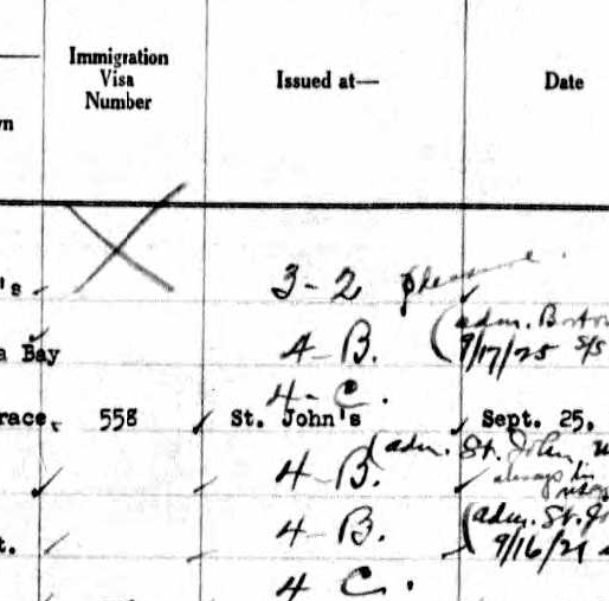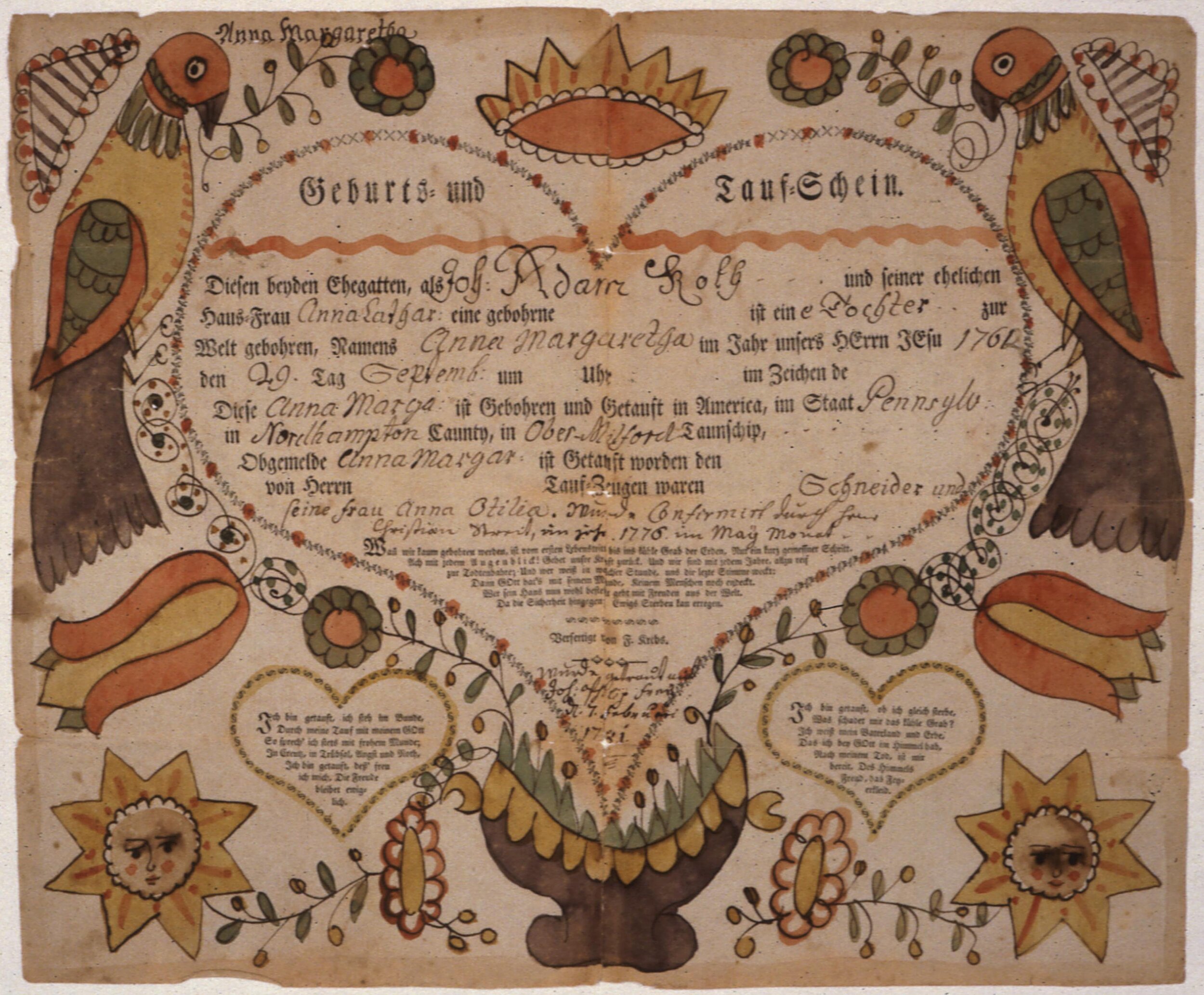Today’s post is a follow-up to a recent blog post, “Passenger Lists: The Meaning Behind the Notations, Abbreviations, and Marks” as I wanted to add a bit more information, specifically about notations you may see on U.S. passenger arrival lists related to the Immigration Act of 1924.
Massachusetts, U.S., Arriving Passenger and Crew Lists, 1820-1963. Ancestry.com. Series Number: T843; NARA Roll Number; 340. Note the highlighted area with notations, that refer to the Immigration Act. Can you decipher these codes using my table further below?
The Immigration Act of 1924, also known as the Johnson-Reed Act or National Origins Quota Act, “limited the number of immigrants allowed entry into the United States through a national origins quota. The quota provided immigration visas to two percent of the total number of people of each nationality in the United States as of the 1890 national census. It completely excluded immigrants from Asia.” (United States Department of the State). It capped the number of annual immigrants allowed at 165,000.
This act also required everyone to present a visa prior to entry. Those that were subject to quota restrictions would have a Quota Immigrant Visa (QIV), while those not would have a Non-Quota Immigrant Visa (NQIV). The Act “exempted from the new quota highly skilled immigrants, domestic servants, specialized workers such as actors and wives or unmarried minor children of U.S. citizens” (Pew) making these examples of non-quota immigrants. Those immigrants whom had been legally allowed entry into the U.S. previously would need a Re-entry Permit (RP), while U.S. citizens would require a Passport Visa (PV).
Starting in July 1, 1924, when this act went into effect, you may see notations on passenger arrival lists made by the immigration inspector at the port of arrival. These numbers and letter combinations referred to different sections and parts of the text of the Immigration Act of 1924, which I summarized in the table below.
| Section | Part | Excerpt from the Immigration Act of 1924 |
|---|---|---|
| 3 | Definition of an Immigrant | |
| 3 | 1 | “A government official, his family, attendants, servants, and employees" |
| 3 | 2 | “An alien visiting the United States temporarily as a tourist or temporarily for business or pleasure” |
| 3 | 3 | “An alien in continuous transit throughout the United States” |
| 3 | 4 | “An Alien lawfully admitted to the United States who later goes in transit from one part of the United States to another through foreign contiguous territory” |
| 3 | 5 | “A bona fide alien seaman serving as such on a vessel arriving at a port of the United States and seeking to enter temporarily the United States solely in the pursuit of his calling as a seaman” |
| 3 | 6 | “An alien entitled to enter the United States solely to carry on trade under and in pursuance of the provisions of a present existing treaty of commerce and navigation” |
| 4 | Non-Quota Immigrants | |
| 4 | a | “An immigrant who is the unmarried child under 18 years of age, or the wife, of a citizen of the United States who resides therein at the time of the filing of a petition under section 9…” |
| 4 | b | “An immigrant previously lawfully admitted to the United States, who is returning from a temporary visit abroad” |
| 4 | c | “An immigrant who was born in the Dominion of Canada, Newfoundland, the Republic of Mexico, the Republic of Cuba, the Republic of Haiti, the Dominican Republic, the Canal Zone, or an independent country of Central or South America, and his wife, and his unmarried children under 18 years of age, if accompanying or following to join him” |
| 4 | d | “An immigrant who continuously for at least two years immediately preceding the time of his application for admission to the United States has been, and who seeks to enter the United States solely for the purpose of, carrying on the vocation of minister of any religious denomination, or professor of a college, academy, seminary, or university; and his wife, and his unmarried children under 18 years of age, if accompanying or following to join him” |
| 4 | e | “An immigrant who is a bona fide student at least 15 years of age and who seeks to enter the United States solely for the purpose of study at an accredited school, college, academy, seminary, or university, particularly designated by him and approved by the Secretary of Labor, which shall have agreed to report to the Secretary of Labor the termination of attendance of each immigrant student, and if any such institution of learning fails to make such reports promptly the approval shall be withdrawn” |
| 5 | Quota Immigrants | |
| 5 | “When used in this Act the term “quota immigrant” means any immigrant who is not a non-quota immigrant…” | |
| 6 | Preferences within Quotas | |
| 6 | 1 | “To a quota immigrant who is the unmarried child under 21 years of age, the father, the mother, the husband, or the wife, of a citizen of the United States who is 21 years of age or over…” |
| 6 | 2 | “To a quota immigrant who is skilled in agriculture, and his wife, and his dependent children under the age of 16 years, if accompanying or following to join him…” |
Above excerpts from The Immigration Act of 1924, also named “An Act of May 26, 1924, Public Law 68-139, 43 STAT 153, to Limit Immigration of Aliens into the United States for Other Purposes” found in The National Archives Catalog. Additional non-relevant sections of the act were not included, but should be referenced as needed.
Looking back at the first image (close-up below), with the passengers sailing from St. John’s Newfoundland and arriving in Boston, Massachusetts in 1925, we see a list of notations in the immigration section:
By referencing the Immigration Act of 1924, through my table higher above, we can decode these notes as follows:
The “3 - 2” would be a tourist or a temporary visitor, for either business or pleasure. We see the remark “pleasure” next to the first reference.
The “4 - B” would be an immigrant, legally admitted to the U.S. before, that is returning from a trip abroad.
The “4 - C” would mean an immigrant born in Canada, Newfoundland, Mexico, Cuba, Haiti, etc. (in this case likely Newfoundland as that’s where they are sailing from) or the immigrant’s wife or minor children
This Immigration Act was in effect in various forms until the 1965 Immigration and Nationality Act, or Hart-Cellar Act, replaced the quota system (Pew), with some restrictions on Asian immigrants repealed earlier, though we still use a system of visas.
Read more about Visa Files at U.S. Citizenship and Immigration Services. Note this immigration visa number written on passenger lists is not the Visa File number you need to request from USCIS.
Sources:
Pew Research Center. “Chapter 1: The Nation’s Immigration Laws, 1920 to Today”. 28 Sept 2015. (https://www.pewresearch.org/hispanic/2015/09/28/chapter-1-the-nations-immigration-laws-1920-to-today/) Accessed 8 October 2021.
The Immigration Act of 1924. ”An Act of May 26, 1924, Public Law 68-139, 43 STAT 153, to Limit Immigration of Aliens into the United States for Other Purposes”. National Archives and Records Administration. (https://catalog.archives.gov/id/5752154) Accessed 7 October 2021.
United States Department of State: Office of the Historian, Foreign Service Institute. “The Immigration Act of 1924 (The Johnson-Reed Act)” (https://history.state.gov/milestones/1921-1936/immigration-act) Accessed 7 October 2021.











